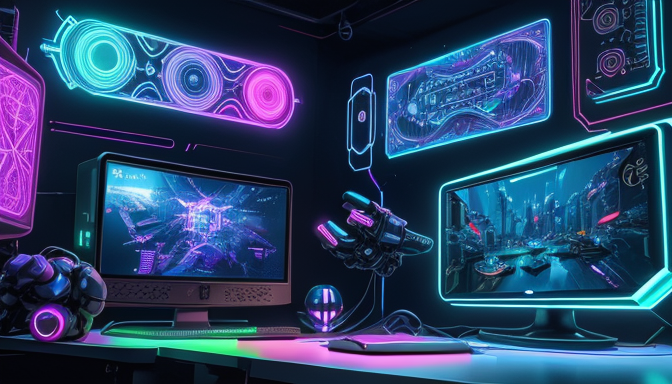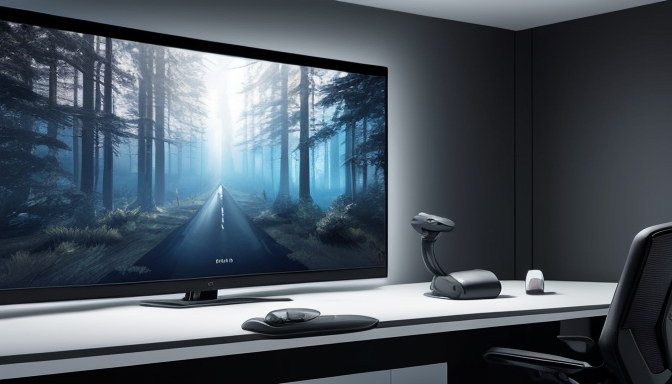As we stand on the brink of a new era in entertainment, virtual reality (VR) is not just a fleeting trend; it’s a powerful force reshaping how we perceive and interact with digital content. Imagine slipping on a headset and instantly being transported to a breathtaking world where the limits of reality are pushed to their extremes. This is the thrilling promise of VR, and it’s just the beginning. With the rapid advancement of technology and the growing acceptance of immersive experiences, the future of VR entertainment is poised to explode in ways we can hardly fathom.
But what does this future look like? For starters, we are witnessing an influx of innovative trends that are redefining user engagement. From social VR platforms that allow friends to hang out in virtual spaces, to interactive storytelling that lets viewers choose their own adventure, the landscape is rich with possibilities. Picture yourself not just watching a movie but stepping into it, influencing the plot with your choices. It’s an experience that blurs the lines between creator and consumer.
Moreover, the technological advancements driving this revolution are nothing short of remarkable. Enhanced graphics, more responsive haptic feedback, and the integration of artificial intelligence are creating hyper-realistic environments that feel alive. These tools are not just making VR more enjoyable; they’re making it more accessible. As hardware becomes more affordable and software more intuitive, we can expect a surge in adoption across various demographics.
In essence, the future of VR entertainment is bright and full of potential. It’s about creating experiences that are not only engaging but also transformative. Are you ready to take the leap into this exciting new world? The adventure is just beginning!
Emerging Trends in VR Entertainment
The landscape of virtual reality (VR) entertainment is undergoing a massive transformation, and it’s an exciting time to be part of this digital revolution. One of the most significant trends is the rise of cross-platform experiences. Imagine being able to dive into a VR game with friends who are on different devices—whether they’re using a headset, a console, or even a mobile device. This seamless interaction is breaking down barriers and making VR more accessible than ever.
Another trend that’s catching fire is the integration of social VR experiences. Platforms like VRChat and Rec Room are creating virtual hangout spaces where users can meet, socialize, and play games together. It’s like stepping into a digital café where the only limit is your imagination! These environments are not just for gaming; they’re evolving into hubs for virtual events, concerts, and even art galleries, allowing users to experience culture in a whole new way.
Moreover, the advent of haptic technology is making waves in how we interact with virtual environments. Companies are developing gloves and suits that provide tactile feedback, making us feel as if we’re truly touching the virtual world. This technology is not just enhancing gaming but is also being explored in therapeutic applications, helping people with phobias or PTSD confront their fears in a controlled setting.
Lastly, AI-driven content creation is on the horizon. Imagine a game that adapts to your play style or a movie that changes its narrative based on your choices! The potential for personalized experiences is limitless. As these trends continue to evolve, they will undoubtedly reshape our understanding of entertainment and interaction in the digital realm.

Technological Advancements Driving VR
The world of Virtual Reality (VR) is not just a fleeting trend; it’s a revolution powered by remarkable technological advancements. Imagine donning a headset and being transported to a fantastical world where the only limit is your imagination. This magic is made possible through a series of innovations that are reshaping the landscape of entertainment. So, what are these game-changing technologies that are driving VR forward?
First off, let’s talk about graphics quality. Gone are the days of pixelated images and awkward movements. With advancements in graphics processing units (GPUs), VR experiences now boast stunning visuals that make you feel like you’re truly part of the action. The realism is so intense that you might just forget you’re sitting in your living room!
Next, we have haptic feedback technology. This is where things get really exciting. Imagine feeling the vibrations of a virtual explosion or the gentle touch of a character reaching out to you. Haptic feedback adds a layer of immersion that engages your senses in ways that traditional media simply cannot. It’s like adding a sprinkle of magic to your experience!
Lastly, let’s not overlook artificial intelligence (AI). AI is revolutionizing how we interact with virtual environments. From creating more responsive and intelligent NPCs (non-player characters) to personalizing user experiences, AI is paving the way for a more engaging and dynamic VR landscape. The potential for storytelling and gameplay is virtually limitless!
In conclusion, the future of VR is bright, fueled by these technological advancements. As we continue to embrace these innovations, the question remains: what incredible experiences await us just around the corner? Buckle up, because the ride is just beginning!
The Impact of VR on Gaming
Virtual Reality (VR) is not just a buzzword anymore; it’s a game-changer in the world of gaming. Imagine stepping into a vibrant, interactive universe where you can literally feel the action around you. This immersive experience is transforming the gaming landscape, creating a paradigm shift that is exciting both developers and players alike. But how exactly is VR impacting gaming?
First off, VR is redefining game design. Traditional games often rely on flat screens and controllers, but with VR, developers can create environments that players can explore in 360 degrees. This means that players aren’t just passive observers; they are active participants in the story. It’s akin to being the hero in your own movie, where every decision you make influences the outcome. For instance, in a VR horror game, the feeling of dread is amplified when you can physically turn around to see what lurks behind you.
Moreover, the engagement levels have skyrocketed. Players are no longer just clicking buttons; they’re using their bodies to interact with the game. This physical involvement fosters a deeper emotional connection to the gameplay. A study found that players who engage in VR gaming report higher levels of satisfaction and enjoyment compared to traditional gaming formats. Imagine battling a dragon, not from the safety of your couch but while standing in your living room, swinging a sword as if it were real!
Additionally, VR is creating a new sense of community. Multiplayer VR games allow players to engage with friends and strangers in ways that were previously impossible. You can team up to conquer challenges or simply hang out in a virtual space, making the experience more social and interactive. As we move forward, the potential for VR in gaming seems limitless, with advancements in technology promising even more incredible experiences.
In summary, the impact of VR on gaming is profound. It’s not just about playing a game anymore; it’s about living it. With every new development, we inch closer to a future where the line between reality and virtual reality blurs even further. Are you ready to dive into this thrilling new world?

VR in Film and Storytelling
Imagine stepping into a movie, where you’re not just a spectator but a participant in the unfolding story. Virtual Reality (VR) is transforming the film industry, creating experiences that are not only visually stunning but also profoundly interactive. Filmmakers are beginning to leverage this technology, allowing audiences to explore narratives from multiple perspectives, effectively turning traditional storytelling on its head.
One of the most exciting aspects of VR in film is the ability to immerse viewers in the story world. Instead of watching a character walk through a forest, you can now stand beside them, feeling the breeze and hearing the rustle of leaves. This level of immersion creates a stronger emotional connection, as viewers can experience the plot in a way that feels personal and immediate. It’s like being a character in your favorite book, where every choice you make can lead to a different outcome.
Moreover, VR enables filmmakers to experiment with non-linear narratives. In traditional films, the story follows a set path, but with VR, audiences can choose their journey. For instance, they might explore different rooms in a haunted house, each revealing unique backstories and plot twists. This interactivity not only enhances engagement but also encourages viewers to revisit the experience, discovering new elements each time.
As we look to the future, the potential for VR in storytelling is limitless. With advancements in technology, we can expect even more immersive experiences that blend real-time graphics and artificial intelligence, creating worlds that feel alive. It’s an exciting time for filmmakers and audiences alike, as we stand on the brink of a new era in cinematic experiences. So, are you ready to don your VR headset and dive into a story where you hold the reins?
Social Interactions in Virtual Spaces
The rise of virtual reality (VR) is not just about immersive experiences; it’s also reshaping the way we connect with others. Imagine stepping into a digital world where you can meet friends from across the globe, attend concerts, or even collaborate on projects in a shared space. This is the new frontier of social interaction! As VR technology advances, it creates opportunities for users to engage with each other in ways that were once limited to the physical realm.
One of the most exciting aspects of VR is its ability to foster genuine connections. Users can create avatars that represent them in these virtual environments, allowing for a sense of presence that text or video chats simply can’t replicate. For instance, think of a virtual coffee shop where you can sit with friends, share ideas, and even play games together, all while feeling as if you are in the same room. This immersive interaction is changing the game!
Moreover, VR platforms are increasingly incorporating social features that enhance user experience. Here are some key elements that are making social interactions in VR more engaging:
- Real-time Communication: Users can talk, gesture, and react to each other in real-time, creating a dynamic social experience.
- Shared Experiences: Whether it’s watching a movie or exploring a new world, shared activities are at the heart of VR social interactions.
- Community Building: Virtual spaces allow users to form communities around shared interests, fostering connections that can lead to lasting friendships.
As we look to the future, the potential for VR to enhance social interaction is immense. With advancements in technology, we can expect even more immersive and interactive experiences that will redefine how we connect and communicate. So, are you ready to dive into a world where your social life can be as vibrant as your imagination?
Frequently Asked Questions
- What is Virtual Reality (VR) entertainment?
Virtual Reality (VR) entertainment immerses users in a digitally created environment, allowing them to interact with 3D worlds in a way that feels real. It’s like stepping into a video game or movie, where you can look around and even move within the space!
- How is VR changing the gaming industry?
VR is revolutionizing gaming by offering experiences that are more immersive than traditional games. Imagine being inside your favorite game, where you can physically dodge obstacles or swing a sword! This level of engagement is reshaping game design and player communities.
- What technological advancements are driving VR?
Innovations like improved graphics, haptic feedback, and AI integration are enhancing the VR experience. These technologies make virtual worlds feel more tangible and responsive, elevating user engagement to new heights!
- How is VR impacting film and storytelling?
Filmmakers are using VR to create interactive narratives where viewers can influence the story. It’s like being the director of your own movie, where you choose what to see and when, making storytelling a more personal experience!
- Can VR enhance social interactions?
Absolutely! VR allows users to connect in virtual spaces, creating new forms of communication. You can hang out with friends in a digital café or attend a virtual concert together, making distance feel irrelevant!

